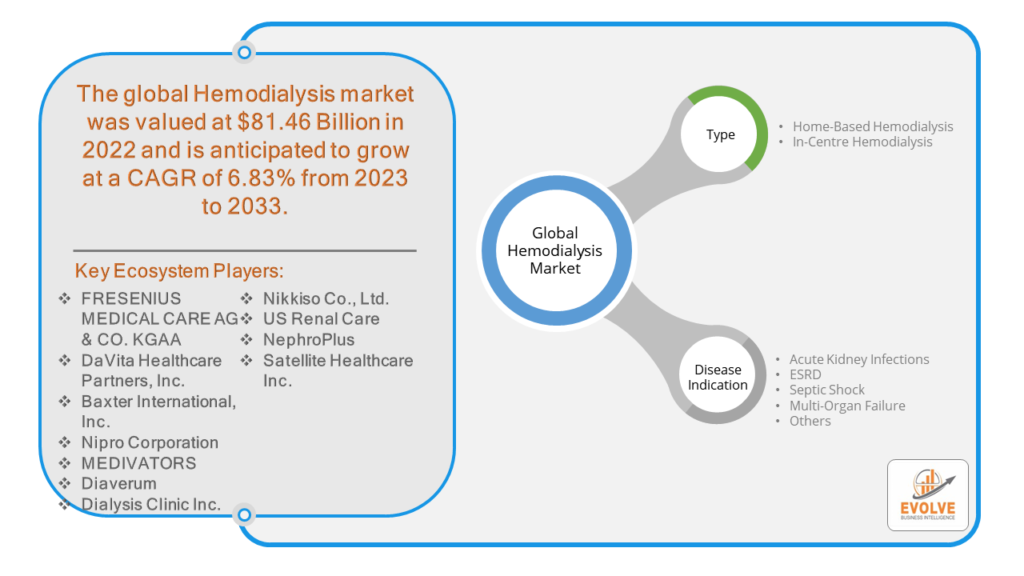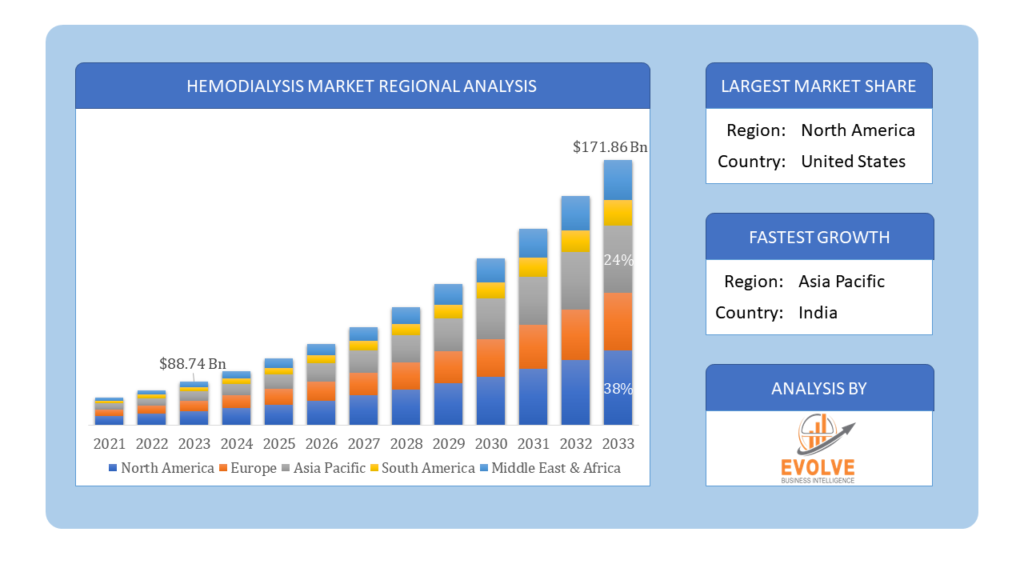Hemodialysis Services Market Overview
The global Hemodialysis market was valued at $81.46 Billion in 2022 and is anticipated to grow at a CAGR of 6.83% from 2023 to 2033. The hemodialysis services market refers to the sector of the healthcare industry that provides services related to hemodialysis, a medical procedure used to treat patients with advanced kidney disease or kidney failure. Hemodialysis is a process that involves removing waste products, excess fluids, and toxins from the blood when the kidneys are no longer able to perform this function adequately.
The market includes various components, such as specialized clinics, hospitals, and healthcare facilities that offer hemodialysis services. These services typically involve the use of hemodialysis machines and related equipment, along with skilled healthcare professionals, including nephrologists, nurses, and technicians, who administer the treatment and monitor patients during the procedure.
The market is driven by factors such as the increasing prevalence of chronic kidney disease, the growing aging population, lifestyle-related health issues leading to kidney problems, and advancements in hemodialysis technology. Access to hemodialysis services is crucial for improving the quality of life and increasing the life expectancy of individuals with kidney disease.
Global Hemodialysis Services Market Synopsis
The COVID-19 pandemic has had a significant impact on the hemodialysis services market. The pandemic posed operational challenges for hemodialysis centers, including disruptions in supply chains, staffing shortages due to illness or quarantine measures, and delays in the maintenance and servicing of hemodialysis equipment. Lockdowns and travel restrictions also affected patients’ ability to access these services. Hemodialysis centers had to implement strict infection control measures and safety protocols to minimize the risk of COVID-19 transmission within their facilities. This included enhanced cleaning and sanitization, PPE requirements for staff, social distancing measures, and changes in scheduling to reduce patient density. The economic downturn resulting from the pandemic affected patients’ ability to afford hemodialysis services, including transportation costs and co-payments. Changes in reimbursement policies and financial support programs were implemented to assist both patients and healthcare providers during this challenging period.
Hemodialysis Services Market Dynamics
The major factors that have impacted the growth of Hemodialysis Services Market are as follows:
Drivers:
Ø Increasing Prevalence of Chronic Kidney Disease (CKD)
The rising incidence of chronic kidney disease globally is a significant driver for the hemodialysis services market. CKD is a prevalent condition, often leading to end-stage renal disease (ESRD), necessitating hemodialysis for proper management. Growing awareness about kidney diseases, their risk factors, and the availability of hemodialysis as a treatment option have driven more individuals to seek early diagnosis and appropriate care, fueling the demand for hemodialysis services. The increasing adoption of home hemodialysis and peritoneal dialysis provides patients with more flexible treatment options. This trend is driven by the desire for greater independence and improved quality of life, stimulating the overall growth of the hemodialysis services market.
Restraint:
- Perception of High Treatment Costs
Hemodialysis treatment is costly, including equipment, supplies, facility maintenance, and skilled healthcare professionals. The financial burden of these high costs can limit access to hemodialysis services for some patients, particularly in low-income regions or for individuals without adequate insurance coverage. Hemodialysis centers must regularly update and maintain their equipment to meet evolving technological standards and ensure patient safety. Keeping up with advancements and maintaining a high standard of care may strain financial resources and impact the economic viability of the center. The availability of qualified healthcare professionals, such as nephrologists, nurses, and technicians trained in hemodialysis, can be limited in certain regions. This shortage can create challenges in adequately staffing and running hemodialysis centers, potentially limiting the access and quality of care.
Opportunity:
⮚ Home Hemodialysis and Remote Monitoring
The growing trend towards home hemodialysis and remote monitoring technologies presents a substantial opportunity. Empowering patients to administer hemodialysis at home, with appropriate supervision and remote monitoring, can improve convenience and enhance treatment outcomes. Telemedicine offers an opportunity to enhance access to healthcare, including hemodialysis services, especially in remote or underserved areas. Virtual consultations can connect patients with healthcare professionals, provide monitoring, and optimize treatment plans. The rise in medical tourism, where patients travel to other countries for medical treatments, including hemodialysis, presents a considerable opportunity. Offering high-quality hemodialysis services to international patients can boost revenue and market expansion. Public health campaigns and initiatives aimed at preventing kidney diseases and promoting early detection present an opportunity to reduce the need for hemodialysis in the first place. This preventive approach can positively impact the market by reducing the incidence of advanced kidney diseases.
Hemodialysis Services Market Segment Overview
By Type
 Based on Type, the market is segmented based on Home-Based Hemodialysis and In-Centre Hemodialysis. The In-Centre hemodialysis service segment is bolstering the market due to its essential role in delivering life-sustaining treatments to individuals with kidney diseases. As the prevalence of kidney-related conditions rises, the demand for hemodialysis services escalates. These services encompass a comprehensive range of treatments, including pre-dialysis assessments, dialysis sessions, post-treatment care, and patient education. The convenience of receiving expert care within specialized centers or even through home-based setups attracts patients seeking efficient and regular hemodialysis.
Based on Type, the market is segmented based on Home-Based Hemodialysis and In-Centre Hemodialysis. The In-Centre hemodialysis service segment is bolstering the market due to its essential role in delivering life-sustaining treatments to individuals with kidney diseases. As the prevalence of kidney-related conditions rises, the demand for hemodialysis services escalates. These services encompass a comprehensive range of treatments, including pre-dialysis assessments, dialysis sessions, post-treatment care, and patient education. The convenience of receiving expert care within specialized centers or even through home-based setups attracts patients seeking efficient and regular hemodialysis.
By Disease Indication
Based on Disease indication, the market has been divided into Acute Kidney Infections, ESRD, Septic Shock and Multi-Organ Failure. ESRD dominates the disease indication segment because of growing adoption of dialysis products among ESRD patients. The demand for hemodialysis services for ESRD patients is substantial and continues to grow due to the increasing prevalence of CKD globally, ultimately leading to a rise in ESRD cases. Aging populations and the escalating incidence of diabetes, hypertension, and other risk factors contribute to the higher prevalence of ESRD, driving the demand for hemodialysis services.
Global Hemodialysis Services Market Regional Analysis
Based on region, the global Hemodialysis Services Market has been divided into North America, Europe, Asia-Pacific, the Middle East & Africa, and Latin America. North America is projected to dominate the use of the Hemodialysis Services Market followed by the Asia-Pacific and Europe regions.
Hemodialysis Services North America Market
North America holds a dominant position in the Hemodialysis Services Market. The region’s dominance can be attributed to various factors. North America has a well-established hemodialysis services market, driven by a high prevalence of chronic kidney disease (CKD) and end-stage renal disease (ESRD). The region also has advanced healthcare infrastructure and widespread adoption of hemodialysis. Important key driver are Aging population, high incidence of diabetes and hypertension, favorable reimbursement policies, technological advancements, and a strong focus on improving healthcare outcomes are key drivers. It also face Challenges like High treatment costs, regulatory compliance, and a shift towards home hemodialysis.
Hemodialysis Services Asia-Pacific Market
The Asia-Pacific region has indeed emerged as the fastest-growing market for the Hemodialysis Services Market industry. Asia-Pacific has a rapidly growing hemodialysis services market due to a large and increasing prevalence of CKD, ESRD, and lifestyle-related diseases. The region is witnessing a rise in healthcare investments and infrastructure development. Increasing incidence of diabetes, hypertension, and CKD, improving healthcare infrastructure, rising awareness, and government initiatives to enhance healthcare access drive the market. Economic disparities, accessibility to healthcare in rural areas, and the need for investments in technology and training are key challenges.
Competitive Landscape
The global Hemodialysis Services Market is highly competitive, with numerous players offering a wide range of software solutions. The competitive landscape is characterized by the presence of established companies, as well as emerging startups and niche players. To increase their market position and attract a wide consumer base, the businesses are employing various strategies, such as product launches, and strategic alliances.
Prominent Players:
- Fresenius Medical Care AG & Co. KGaA
- DaVita Healthcare Partners Inc.
- US Renal Care
- Dialysis Clinic Inc.
- US Renal Association
- Baxter International Inc.
- Gambro AB
- Nikkiso Co. Ltd.
- Nipro Corporation
- Satellite Healthcare Inc.
Key Development
In March 2020, Fresenius Medical Care expanded its home dialysis offerings, emphasizing the importance of home-based treatments during the COVID-19 pandemic. They also announced collaborations to enhance remote patient monitoring and telehealth services.
In 2020, Baxter introduced the SHARESOURCE 2 telehealth platform for Peritoneal Dialysis (PD) patients, enhancing remote patient management and communication between patients and healthcare providers.
Scope of the Report
Global Hemodialysis Services Market, by Type
- Home-Based Hemodialysis
- In-Centre Hemodialysis
Global Hemodialysis Services Market, by Disease Indication
- Acute Kidney Infections
- ESRD
- Septic Shock
- Multi-Organ Failure
Global Hemodialysis Services Market, by Region
- North America
- US
- Canada
- Mexico
- Europe
- UK
- Germany
- France
- Italy
- Spain
- Benelux
- Nordic
- Rest of Europe
- Asia Pacific
- China
- Japan
- South Korea
- Indonesia
- Austalia
- Malaysia
- India
- Rest of Asia Pacific
- South America
- Brazil
- Argentina
- Rest of SouthAmerica
- Middle East &Africa
- Saudi Arabia
- UAE
- Egypt
- SouthAfrica
- Rest of Middle East & Africa
| Parameters | Indicators |
|---|---|
| Market Size | 2033: $USD607.2Billion |
| CAGR | 4.41% CAGR (2023-2033) |
| Base year | 2022 |
| Forecast Period | 2023-2033 |
| Historical Data | 2021 |
| Report Coverage | Revenue Forecast, Competitive Landscape, Growth Factors, and Trends |
| Key Segmentations | Type, Disease Indication |
| Geographies Covered | North America, Europe, Asia-Pacific, Latin America, Middle East, Africa |
| Key Vendors | Fresenius Medical Care AG & Co. KGaA, DaVita Healthcare Partners Inc., US Renal Care, Dialysis Clinic Inc., US Renal Association, Baxter International Inc., Gambro AB, Nikkiso Co. Ltd., Nipro Corporation and Satellite Healthcare Inc. |
| Key Market Opportunities | • Home Hemodialysis and Remote Monitoring |
| Key Market Drivers | • Increasing Prevalence of Chronic Kidney Disease (CKD) • Home Hemodialysis and Peritoneal Dialysis Options |
REPORT CONTENT BRIEF:
- High-level analysis of the current and future Hemodialysis Services Market trends and opportunities
- Detailed analysis of current market drivers, restraining factors, and opportunities in the future
- Hemodialysis Services Market historical market size for the year 2021, and forecast from 2023 to 2033
- Hemodialysis Services Market share analysis at each product level
- Competitor analysis with detailed insight into its product segment, Government & Defense strength, and strategies adopted.
- Identifies key strategies adopted including product launches and developments, mergers and acquisitions, joint ventures, collaborations, and partnerships as well as funding taken and investment done, among others.
- To identify and understand the various factors involved in the global Hemodialysis Services Market affected by the pandemic
- To provide a detailed insight into the major companies operating in the market. The profiling will include the Government & Defense health of the company’s past 2-3 years with segmental and regional revenue breakup, product offering, recent developments, SWOT analysis, and key strategies.








